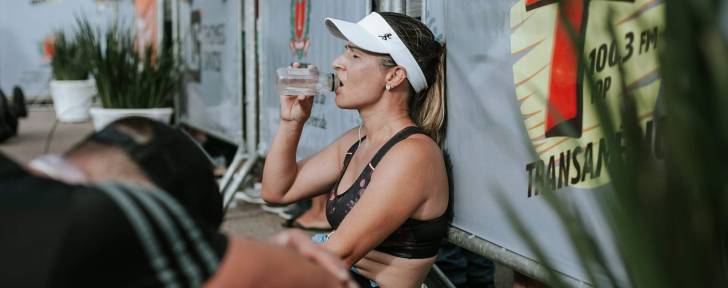La récupération en course à pied : 10 astuces pour progresser
Par Anthony Publié le 30/09/2025 à 14h00 Temps de lecture : 5 minutes
L'entraînement en course à pied est une science, mais la progression est un art. Et cet art réside en grande partie dans la maîtrise d'un concept souvent sous-estimé : la récupération. Dans l'euphorie d'une bonne période d'entraînement, il est facile de se laisser emporter par l'envie de courir toujours plus, au risque de négliger le repos. C'est une erreur fatale. Car si l'entraînement est le moment où vous cassez votre corps pour le pousser à s'adapter, la récupération est celui où vous le reconstruisez, en le rendant plus fort qu'auparavant. C'est pendant que vous vous reposez que la magie opère réellement. Voici pourquoi la récupération est la clé de votre progression et comment l'optimiser grâce à 10 conseils essentiels.
🔄 Pourquoi la récupération est-elle synonyme de progression ?
Pour comprendre l'importance de la récupération, il faut d'abord saisir le principe de la surcompensation. L'entraînement, qu'il soit intense ou de longue durée, est un stress pour le corps. Il entraîne des micro-déchirures musculaires, un épuisement des réserves énergétiques (glycogène) et une fatigue du système nerveux. À la fin d'une séance, votre niveau de performance est temporairement plus bas qu'avant l'effort.
C'est alors que la récupération entre en jeu. Le corps ne se contente pas de revenir à son état initial. Il s'adapte en se renforçant pour pouvoir mieux supporter un effort similaire la prochaine fois. Il y a une surcompensation. Vos muscles se consolident, votre système cardiovasculaire devient plus efficace, et vos réserves d'énergie se rechargent. Sans une bonne récupération, ce processus s'arrête, et vous risquez la stagnation, la fatigue chronique, voire la blessure. Pour en savoir plus sur ce principe fondamental, lisez notre article sur la surcompensation.
💧 Les fondations de la récupération : les 3 piliers essentiels
Avant de se lancer dans des techniques plus complexes, il est crucial de maîtriser les trois piliers de base de la récupération. Sans eux, le reste n'aura qu'un effet limité.
Pilier 1 : La nutrition, le carburant de la reconstruction
La nutrition est le moteur de la récupération. Après un effort, vos muscles ont besoin d'être réparés et vos réserves d'énergie rechargées. Le moment le plus crucial est la « fenêtre métabolique », la période de 30 à 60 minutes suivant l'effort, où votre corps est le plus réceptif aux nutriments. Privilégiez un apport en glucides pour reconstituer le glycogène musculaire et en protéines pour la réparation des fibres. Des exemples simples et efficaces :
- Un verre de lait au chocolat (idéal, car il combine glucides et protéines).
- Une banane avec du beurre de cacahuète.
- Une boisson de récupération.
Une bonne alimentation au quotidien, riche en fruits, légumes, protéines et glucides complexes, est la meilleure garantie d'une récupération optimale. Pour plus de détails, consultez notre guide sur la nutrition du coureur.
Pilier 2 : L'hydratation, la circulation de la vie
Notre corps est composé d'environ 60 % d'eau. Pendant la course, vous perdez de l'eau et des électrolytes par la transpiration. Se réhydrater est essentiel pour restaurer le volume sanguin, qui transporte les nutriments vers les muscles et aide à l'élimination des déchets métaboliques. Buvez de l'eau tout au long de la journée, pas seulement après l'effort. Pour vérifier votre niveau d'hydratation, regardez la couleur de vos urines : si elles sont claires, vous êtes bien hydraté.
Pilier 3 : Le sommeil, le super-pouvoir de la régénération
C'est le pilier le plus important et le plus négligé. C'est pendant le sommeil profond que la magie opère pour le coureur. Votre corps sécrète l'hormone de croissance, qui est vitale pour la réparation musculaire et la croissance des tissus. Un sommeil insuffisant (moins de 7 heures par nuit pour la plupart) augmente le cortisol (l'hormone du stress) et freine la récupération. Apprenez à mieux dormir pour optimiser vos performances.
🤸♀️ La récupération active : bouger pour mieux récupérer
La récupération n'est pas toujours passive. Certaines actions simples et légères peuvent grandement accélérer le processus.
Astuce 1 : Le retour au calme post-séance
Ne vous arrêtez pas net après une séance intense. Terminez par 5 à 10 minutes de footing très lent pour permettre à votre rythme cardiaque de redescendre progressivement et à votre corps de commencer à éliminer les déchets métaboliques (comme le lactate). C'est une transition douce et essentielle pour votre organisme.
Astuce 2 : Le footing de récupération
Un footing léger le lendemain d'une séance intense est une excellente façon d'accélérer la récupération. L'effort très modéré stimule la circulation sanguine, ce qui aide à transporter l'oxygène et les nutriments vers les muscles fatigués tout en évacuant les déchets. L'allure doit être très facile, presque une marche rapide. Ce type de séance est d'ailleurs la clé d'une progression durable.
Astuce 3 : Le rouleau de massage (Foam Roller)
Le foam roller est devenu un outil indispensable pour de nombreux coureurs. En roulant sur les muscles (mollets, cuisses, fessiers), il permet de relâcher les tensions musculaires, d'améliorer la circulation et de réduire les courbatures. Astuce : Appliquez une pression constante et roulez lentement sur les zones de tension pendant 30 secondes, ou jusqu'à ce que vous ressentiez un relâchement.
🧊 Les techniques de récupération "avancées"
Ces techniques complémentaires peuvent donner un coup de pouce significatif à votre récupération, surtout après des séances très éprouvantes.
Astuce 4 : Les bains de glace et la douche froide
La cryothérapie a fait ses preuves chez les athlètes de haut niveau. L'exposition au froid intense après l'effort provoque une vasoconstriction (rétrécissement des vaisseaux sanguins), ce qui réduit l'inflammation et les œdèmes. Lorsque vous sortez du froid, vos vaisseaux se dilatent, provoquant un afflux de sang frais, riche en oxygène et en nutriments, dans vos muscles. Pour le coureur amateur, une douche froide de 1 à 2 minutes, en insistant sur les jambes, est un excellent moyen de bénéficier de cet effet.
Astuce 5 : La compression
Les chaussettes ou manchons de compression sont conçus pour exercer une pression graduée sur les muscles des jambes. Cette pression favorise un meilleur retour veineux, ce qui permet au sang "usé" de remonter plus efficacement vers le cœur pour être réoxygéné. Le résultat est une réduction des gonflements et des courbatures, et une sensation de jambes plus légères.
Astuce 6 : L'étirement
Les étirements après la course peuvent aider à relâcher les muscles et à restaurer leur souplesse. Toutefois, évitez les étirements statiques longs et intenses juste après un effort, car cela pourrait accentuer les micro-déchirures. Préférez des étirements doux ou dynamiques pour ramener les muscles à leur longueur de repos. Consultez notre article sur l'échauffement pour plus de détails sur les étirements dynamiques.
Astuce 7 : L'astuce des jambes en l'air
C'est la technique la plus simple, accessible à tous. Allongez-vous sur le dos et posez vos jambes à 90 degrés contre un mur pendant 10 à 15 minutes. Cette position utilise la gravité pour aider le sang à circuler et à drainer les fluides accumulés dans les membres inférieurs. C'est un moyen rapide et efficace de soulager la sensation de jambes lourdes.
Astuce 8 : Boire de l'eau riche en bicarbonates
Les eaux gazeuses comme la St-Yorre sont riches en bicarbonates de sodium. Après un effort intense, l'accumulation d'acide lactique acidifie les muscles. Les bicarbonates agissent comme un tampon et aident à restaurer l'équilibre acido-basique de l'organisme, ce qui peut réduire les courbatures et accélérer la récupération.
Astuce 9 : La gestion du stress
Le stress quotidien est une forme de fatigue qui s'ajoute au stress de l'entraînement. Le cortisol produit par le stress peut ralentir la récupération. Des techniques de relaxation, de méditation ou de sophrologie peuvent vous aider à mieux gérer ce stress et à optimiser votre état de récupération général. Notez qu'un simple footing en endurance fondamentale est aussi un excellent antidépresseur naturel, ce qui aide grandement la gestion du stress. Apprenez à gérer votre fatigue globale pour mieux progresser.
La récupération n'est pas la pause qui suit l'effort, c'est la suite logique et indispensable de l'entraînement. En la traitant avec la même rigueur que votre plan de course, vous mettez toutes les chances de votre côté pour atteindre vos objectifs, éviter les blessures et prendre un plaisir durable à la course à pied.
🧠 FAQ - Récupération du coureur
❓ Faut-il s'étirer avant ou après une course ?
On s'étire dynamiquement (mouvements avec amplitude croissante) avant de courir et de manière très douce et passive après. Les étirements statiques prolongés avant une course peuvent augmenter le risque de blessure. Après la course, ils peuvent aider à réduire les tensions, mais il est important qu'ils soient doux et non forcés.
❓ Est-ce que les massages sont bénéfiques ?
Oui, les massages (par un professionnel ou à l'aide d'un rouleau de massage) améliorent la circulation sanguine, réduisent les tensions musculaires et peuvent diminuer les courbatures. Un massage post-course peut grandement accélérer la récupération.
❓ Quand dois-je manger après une course ?
Idéalement, dans les 30 à 60 minutes suivant la fin de votre effort. Cette période, appelée "fenêtre métabolique", est le moment où votre corps est le plus efficace pour reconstituer ses réserves de glycogène et réparer ses muscles.
❓ Est-ce que je peux courir avec des courbatures ?
Oui, si les courbatures sont légères, un footing très lent peut même aider à les soulager en améliorant la circulation sanguine. Cependant, si la douleur est vive ou que les courbatures sont très intenses, il est préférable de prendre un jour de repos complet.
❓ Quelle est la différence entre la récupération active et passive ?
La récupération passive est un repos total (sieste, jour de repos). La récupération active est une activité physique à très faible intensité (footing très lent, marche, vélo) qui aide à l'élimination des déchets métaboliques et à la circulation sanguine sans créer de stress supplémentaire.
❓ Les boissons de récupération sont-elles vraiment utiles ?
Pour la plupart des coureurs, une alimentation équilibrée suffit. Cependant, pour un coureur qui s'entraîne de manière très intense ou qui a peu de temps pour préparer un repas post-effort, une boisson de récupération peut être un excellent moyen de fournir rapidement les nutriments nécessaires (glucides, protéines, électrolytes) pour relancer le processus de récupération.







